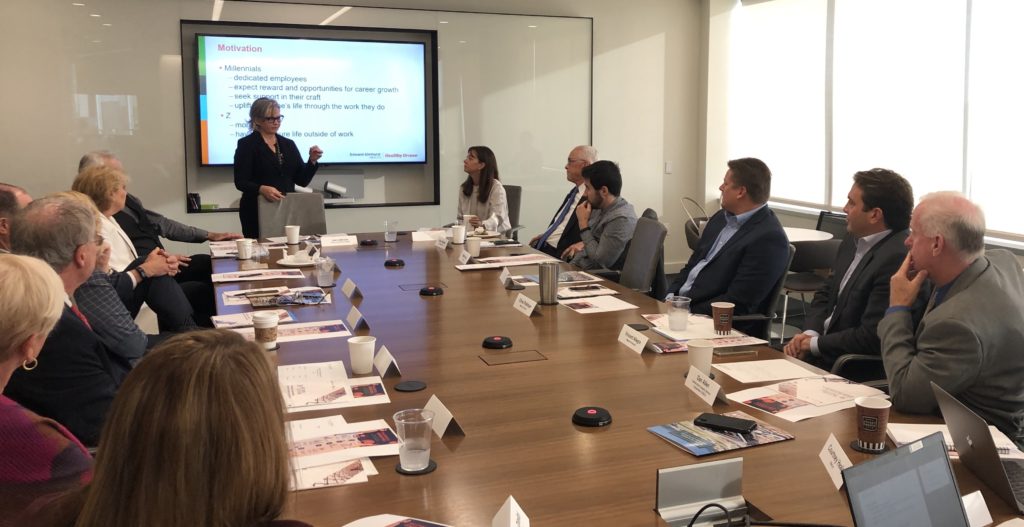How to Navigate Generational Diversity, Engage your Workforce and Create a Winning Culture
DuPage County business leaders gathered on Wednesday, September 18 at a breakfast hosted by Choose DuPage and DuPage County Board Chairman, Dan Cronin to discuss how to navigate generational diversity, engage your workforce and create a winning culture.

The discussion was led by Jen Ullrich, Leadership Development and Employee Experience System Director at Edward-Elmhurst Health. Attendees included a diverse range of representatives from DuPage businesses and employers including:
- Advocate Good Samaritan Hospital
- Ball Horticultural Company
- Benedictine University
- CBRE
- Construction Industry Service Corporation (CISCO)
- DuPage County
- Edward-Elmhurst Health
- First Midwest Bank
- Grant Thornton
- GrowIt!
- MACLYN
- Mesirow Financial
- US Bank
- Whitney Architects
On behalf of Chairman Cronin, Choose DuPage’s president and CEO, Greg Bedalov welcomed everyone to the event. “Workforce is a top concern for businesses today. Low unemployment rates make it difficult to not only hire staff, but also to retain them,” said Bedalov. “Today’s workforce is comprised of three distinct generations, and we are on the precipice of hiring a fourth. Given these market forces, it’s essential our employers understand how to engage and retain workers of all generations.”
The Workforce in DuPage
- The bulk of DuPage County’s workforce is between 25-64 years old.
- DuPage County has a high labor participation rate: 69.3%, compared to 65.3% in Illinois and 63.3% nationally.
- The prime-age participation rate (ages 25-54) is also higher in DuPage at 86.5%, compared to 83.6% in Illinois and 81.6% nationally.
- 4% of the workforce is Asian, more than twice the number in Illinois and nationwide.
- The workforce is highly educated, with 50.9% holding a bachelor’s degree or higher.

Ullrich began the discussion by cautioning against sweeping generalizations and stereotypes. “At its core, generational diversity is an issue of differences. Employers should honor and respect those differences and focus on identifying individual drivers. These can sometimes reflect generalizations, but sometimes not,” said Ulrich.
With that in mind, Ullrich presented the following generalizations to help better understand the differences between Millennials (born 1977-1997) and Generation Z (Born 1998-today).
| Work Priorities | |
| Millennials | Generation Z |
|
|
| Motivation | |
| Millennials | Generation Z |
|
|
| Preferences | |
| Millennials | Generation Z |
|
|
| Changing Roles | |
| Millennials | Generation Z |
|
|
|
|
| Communication | |
| Millennials | Generation Z |
|
|
|
|
|
|
KEY TAKEAWAYS
- Employers should embrace technology as a recruiting tool—provide a seamless digital experience, build out social media and content.
- Build your company’s culture with a clear mission and values. Every generation wants to be part of a community.
- Evolve your work environment to reflect their needs: flexibility, opportunities for development, work/life balance, etc…
- Today’s workforce is more diverse than ever before, and the younger generations demand a dedication to diversity and inclusion.
- Understand the cognitive diversity of your employees and focus on developing their individual strengths.
- Create strategies that will open the lines of communication across the generations. This requires understanding how people want to communicate and dedicating time or resources towards it.
Additional Resources
Return on culture, proving the connection between culture and profit.
Published by: Grant Thornton
Culture drives business performance. It’s a simple concept, and one that most executives believe in. But few actually understand how to act on it. Why? Because we live in an ROI-driven world, and no one has ever taken the time to quantify return on culture. Until now.
Grant Thornton’s Return on Culture report is a groundbreaking study that provides quantifiable evidence that investing in culture leads to measurable financial gains. Culture can no longer be seen as a soft extra. Culture is now a proven science. And understanding how to invest in it is critical for executives who truly care about their bottom line.
DOWNLOAD THE REPORT

